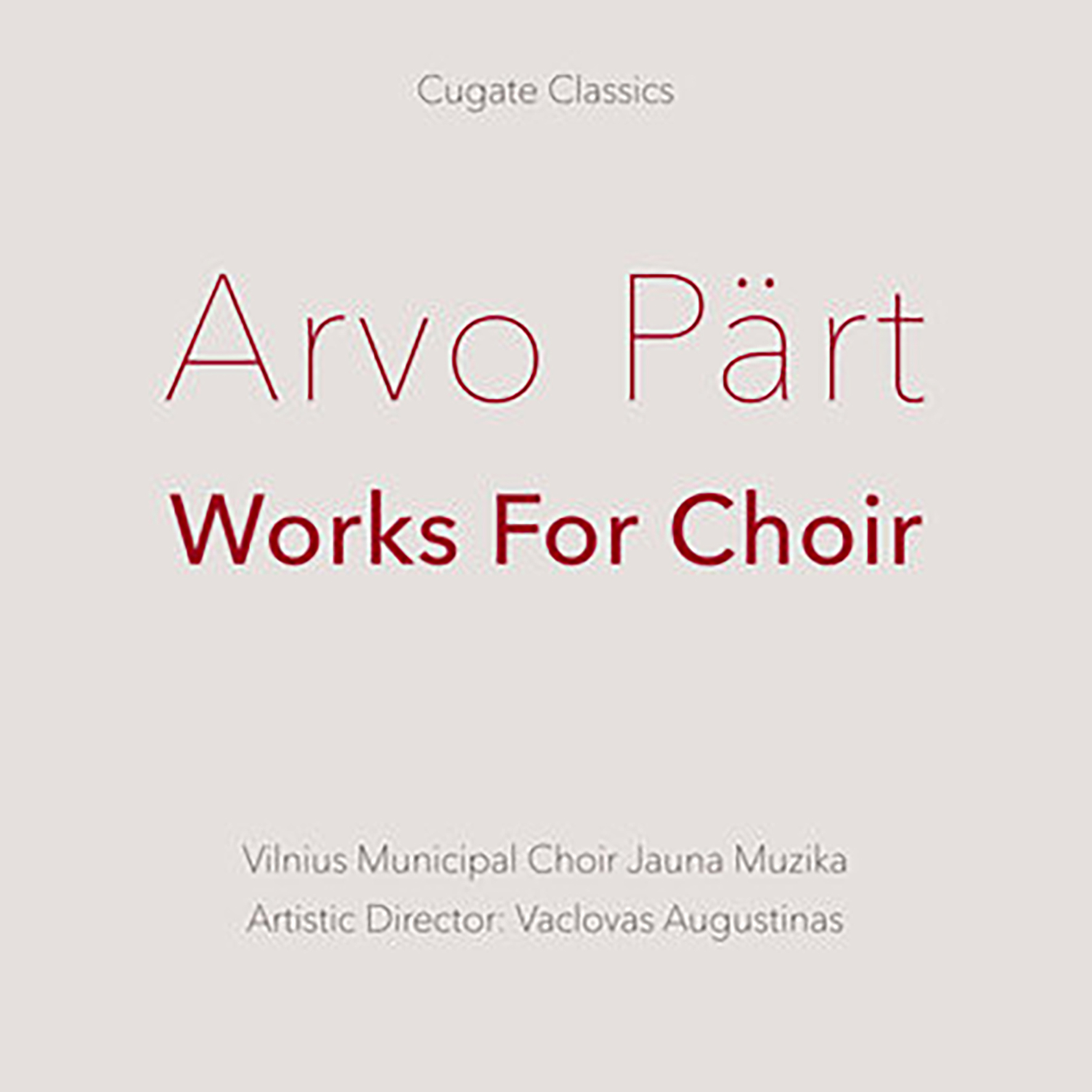Arvo Pärt, "Works for Choir"
 Much like everyone else with a deep interest in experimental music, I have spent a good amount of time exploring the more avant-garde side of 20th century classical music. Estonian composer Arvo Pärt is admittedly not an artist who fits particularly comfortably in that milieu, as he took a far more unique and anachronistic path than most of his peers and embraced Gregorian chants and simple melodicism rather than dissonance, conceptual art, complicated harmonies, electronics, or Eastern drones. That path has rightfully made him one of the most frequently performed contemporary composers, but his work did not make a deep impact on me until I heard the sublime "Spiegel im Spiegel" in Gus van Zant's similarly sublime Gerry. After that revelatory experience, I immediately dove headlong into Pärt's classic ECM albums and they have been a fixture in my life ever since, but I was completely unaware of this album (originally released on the German label Beaux in 2001). Now that it has been reissued, I can see why these pieces did not initially make the same cultural impact as some of Pärt's other work, but I can also see why they eventually found an audience regardless: Works for Choir feels like a dispatch from an alternate timeline in which Bach was never shouldered aside by folks like Schoenberg and Stravinsky and simple beauty never fell out of favor.
Much like everyone else with a deep interest in experimental music, I have spent a good amount of time exploring the more avant-garde side of 20th century classical music. Estonian composer Arvo Pärt is admittedly not an artist who fits particularly comfortably in that milieu, as he took a far more unique and anachronistic path than most of his peers and embraced Gregorian chants and simple melodicism rather than dissonance, conceptual art, complicated harmonies, electronics, or Eastern drones. That path has rightfully made him one of the most frequently performed contemporary composers, but his work did not make a deep impact on me until I heard the sublime "Spiegel im Spiegel" in Gus van Zant's similarly sublime Gerry. After that revelatory experience, I immediately dove headlong into Pärt's classic ECM albums and they have been a fixture in my life ever since, but I was completely unaware of this album (originally released on the German label Beaux in 2001). Now that it has been reissued, I can see why these pieces did not initially make the same cultural impact as some of Pärt's other work, but I can also see why they eventually found an audience regardless: Works for Choir feels like a dispatch from an alternate timeline in which Bach was never shouldered aside by folks like Schoenberg and Stravinsky and simple beauty never fell out of favor.
While he certainly evolved into an iconoclastic composer by the time he reached middle age, it is worth noting that Pärt did not instantly burst onto the scene with a fully formed aesthetic of his own and mostly spent his early years in the thrall of the usual classical influences.I say "mostly" because Pärt's native Estonia was controlled by the Soviet Union for much of his life, which made it difficult to acquire music that was not government-approved.In fact, Pärt's own early twelve-tone-inspired works were themselves banned by Soviet censors, triggering both a deep depression and "the first of several periods of contemplative silence, during which he studied choral music from the 14th to 16th centuries."Eventually he started composing again, but after finishing his Third Symphony (1971), he started looking even further back for inspiration, immersing himself deeply in early religious music like plainsong and Gregorian chant.Unfortunately, the Soviet authorities were not fond of his religious-themed work from this period either, so his problems and frustrations continued.Happily, however, the Arvo Pärt that we all know and love reinvented himself and re-emerged to enter his most fruitful creative period in the late 1970s, as many of his best-loved and most influential works were composed during a single stretch when he was in his early forties.That chronology is interesting because the more overtly conventional pieces collected on Works for Choir date from roughly a decade later (1988 -1991).In some ways, that curious progression makes sense, as Pärt's trajectory seems to have been one leading to greater heights of both religiosity and simplicity, yet he still remained a deeply adventurous composer in his compositional techniques.
For the most part, almost none of these eleven pieces would result in a raised eyebrow if they turned up in a Christian mass (Pärt converted to Orthodox Christianity in the early 1970s), though the opening "The Beatitudes" does feel unusually intense and bracing for such fare.Part of that is due to the almost darkly psychedelic organ finale, but there are also several unusual compositional tricks at work before that point.The text of the piece (in English) is taken from The Sermon on the Mount, but Pärt emphasized passages by writing each "each clause…in a different harmonic key" while "the central pitch of the recitation constantly rises, increasing the tension."Then, after the crescendo, the same process unfolds in reverse.All of the album's other major stand-alone pieces follow soon after, though "Magnificat" and "Nun eile ich zu euch" seem to hew fairly closely to the expected Christian choral tradition.Both are, of course, quite beautiful.They just are not particularly radical.I suppose "Summa" is not all that overtly radical either, but is an achingly gorgeous album highlight with an intriguing history.According to the original CD, the piece dates from 1990, but the choral version that appears here actually dates back from Pärt's late ‘70s heyday.He has since repurposed the piece several times as an instrumental work, however, which makes sense: its lyrical basis in the Latin Credo would not have been acceptable to Soviet censors, so Pärt gave it both a title that "hides a coded message" and a circular structure that "conveys a symbolic meaning."The remainder of the album is devoted to a series of shorter pieces that collectively form "Sieben Magnificat – Antiphonen," a collection of prayers (in German) composed in Pärt’s signature tintinnabuli style.While intended as a seven-part whole, the various sections were designed to contrast each other various ways, so it is not uncommon for individual sections to be performed by themselves.
Sadly, my grasp of early religious music and Pärt's compositional intricacies is not quite deep enough for me to fully appreciate the various innovations lurking in the structure of these pieces, nor am I sufficiently versed in Christianity to grasp the deeper meaning of the texts Pärt chose.As such, Works for Choir does not feel nearly as singular or subversive as it might seem to a classical music scholar.Instead, it feels like excerpts from an especially good religious mass composed in an earlier time, which is just fine by me.It almost makes me nostalgic for a less secular era: while the old adage that the devil gets all the good music certainly has some truth to it, it is equally true that a passionate belief in a higher power has inspired quite a lot of towering masterpieces of both music and architecture over the years.It is certainly hard to imagine either Simon Finn or David Tibet reaching their most fiery heights without some kind of spiritual drive behind them and the same is true of Pärt.While Works for Choir does not disabuse me of my firm belief that Pärt reached his creative zenith in the late '70s, my only real issue with this album is that it blurs together with the work of other composers in a way that his finest work does not.Within the context of Pärt's oeuvre, these pieces are more significant as a document of his evolution than as a crucial album, though I would certainly feel comfortable including "Summa" and "The Beatitudes" among his landmark works.Within the context of classical music as a whole, however, Works for Choir is a strong collection that scratches roughly the same itch as a Bach mass or the better work from Pärt's fellow holy/mystic minimalists like Tavener or Górecki.
Samples can be found here.



